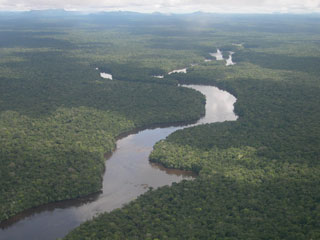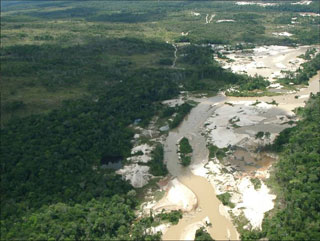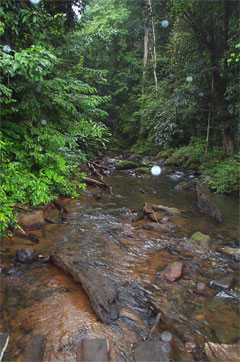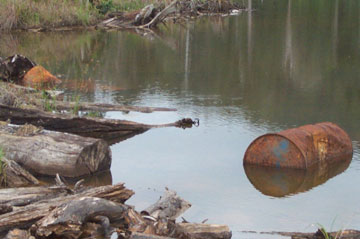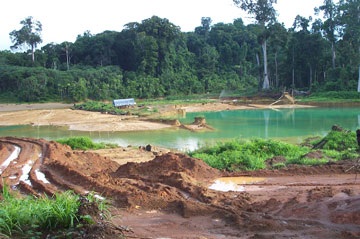Mining in Venezuelan Amazon threatens biodiversity, indigenous groups
Mining in Venezuelan Amazon threatens biodiversity, indigenous groups
Rhett Butler, mongabay.com
November 9, 2006
|
|
Troubles are mounting in one of Earth’s most beautiful landscapes. Deep in the Venezuelan Amazon, among ancient forested tabletop mountains known as tepuis, crystalline rivers, and breathtaking waterfalls, illegal gold miners are threatening one of world’s largest remaining blocks of wilderness, one that is home to indigenous people and strikingly high levels of biological diversity. As the situation worsens — a series of attacks have counted both miners and indigenous people as victims — a leading scientific organization has called for the Venezuelan government to take action.
The drama is playing out in the southern Venezuelan state of Bolivar, near the border of Brazil and Guyana, in the Caroni and Caura River basins. The southern-most of these rivers, the Caura, is the second largest river draining the Guiana shield, highlands that separate the Orinoco and Amazon River basins. Characterized by lowland tropical rainforest, the Caura basin has impressive levels of biological diversity — 2,600 vascular plant species, 168 mammal species, 475 bird species, 34 amphibian species, 53 reptile species, and 441 species of fish have been identified to date — and stores some 700 million metric tons of carbon, or about the amount released by 162 million cars in a year.
The region is also home to indigenous groups — including the Ye’kwana, Sanema and Hoti — who rely heavily upon local rivers for drinking water, food, and transportation. Being one of the most isolated parts Amazonia, these Indians live in mostly traditional ways.
A golden problem
An accident of geography has put this biodiversity and these indigenous populations at risk. The Guiana shield is incredibly old, with exposed rock dating back to the Precambrian period some 600 million years ago. This geology, like that of parts of West Africa, Western Australia, and the Brazilian Shield, produces rich deposits of gold, diamonds, iron, and bauxite. While these have long been exploited, since the early 1990s the region has experienced a gold rush rivaling those of 19th century in the United States, Australia, Canada, New Zealand, and South Africa. Much of this occurred in the Brazilian state of Roraima, but in recent years, informal miners have moved across lightly patrolled borders into the neighboring countries of northern South America.
|
Mining: before and after
|
Dr. David Hammond, principal at NWFS Consultancy, has studied the environmental and socioeconomic consequences of land-use in the region for more than 15 years, says that the shift is driven by two significant changes, a crackdown on illegal mining in Brazil and a global surge in gold prices.
“Two important events have taken place, one in Brazil and one on the world stage, that has changed the regional gold mining dynamic,” explained Hammond. “With the election of Lula da Silva, a noticeable decline in garimpeiro, or artisanal, mining has taken place with increased enforcement of tribal land integrity and national land-use laws. Consequently, these miners have now moved across the extremely porous and virtually un-monitored northern border of Brazil into Venezuela, Guyana, Suriname and French Guiana.”
“At the same time, the international gold price has continued to rise. This makes mining of low-grade gold deposits economic. The region has significant gold resources, but most of the unexploited deposits are low-grade. Events taking place in the Caura river basin is the most recent example of a dynamic taking place across most of northeastern forested areas in South America” said Hammond.
Environmental concerns
|
|
While in Venezuela and Suriname much of the area is nominally protected on paper, in reality national parts are becoming dotted with illegal settlements, clandestine landing strips sometimes used for drug trafficking and other smuggling, and small scale mining operations. In the nearby Caroni and other areas, this informal mining sector is having a significant environmental impact — one that will likely be replicated in the Caura with the September invasion of more than 600 miners into the basin.
Miners rely heavily on hydraulic mining techniques, blasting away at river banks with high-powered water cannons and clearing forests to expose potential gold-yielding gravel deposits. Gold is usually extracted from this gravel using a sluice box to separate heavier sediment and mercury used to amalgamate the precious metal. While most of the mercury is removed for reuse or burned off, some invariably ends up in rivers.
“The main problem with this type of gold mining is that it is almost entirely unmanaged in every aspect.” explained Hammond. “Mercury sales are poorly regulated and its use is widespread. Most often mercury recovery, through the use of retorts, is not undertaken. The result, operators inhale mercury vapor, airborne mercury is dry deposited across many areas and liquid mercury makes its way into the aquatic environment. Once there, it is methylated, taken up by benthic feeders, who then are eaten by predatory fish, and then up through the food chain. ”
|
|
Hammond says that bioaccumulation of mercury in fish poses health threats to people living downstream.
“Fish account for the major share of protein in the diet of local residents, creating well-documented accumulation, particularly in children,” he said “The impacts of mercury on humans is well-established.” Mercury accumulation in humans has been tied to neurological damage and birth defects.
“Further,” added Hammond, “poorly managed mining sites create conditions ideally suited to mosquito breeding, making mining camps hotspots of vector-borne disease transmission. These diseases [malaria, dengue fever] are then spread further as untreated miners return to their communities and families.”
Hammond says these effects are long-lasting.
“To place in context, there are still lakes in the Sierra Nevada Mountains of California that remain off-limits to fishing and swimming due to uncontrolled mercury use during the California gold rush more than 120 years ago. The sites continue to record toxic mercury bioaccumulation according to studies conducted by the United States Geological Survey (USGS).”
|
|
Mining can also wreak other forms of havoc. Dissolved sediments stirred up by mining activities cause have detrimental effects on aquatic flora and fauna, while interfereing with river navigation and posing risks to hydroelectric operations, like Guri dam, the world’s second largest hydroelectric dam, located in the Caroni River Basin. On land, recovery of the cleared forest can be impeded by damaged soil and areas formerly forested may be transformed to fire-prone savanna as trees fail to recolonize once tough grasses take hold. Jaqueline Farías, Venezuela’s Minister of Environment, said last month that it will take 300 years to re-plant destroyed forest in the area and 70 years to decontaminate areas polluted by the miners.
Increasingly bloody
Beyond the environmental impact, mining is causing social upheaval in the Caura Basin. In recent months hundreds of miners from the Brazilian states of Para, Amapa, and Mato Grasso but also from Venezuela and Guyana and Colombia have flooded into Venezuelan forests — a situation is replicated in southern Guyana, western Suriname, and French Guiana (where miners are implicated in the murder of two ecotourism guides in Nouragues Nature Reserve). After miners launched an intimidation campaign against indigenous groups that involved arson, death threats, and the destruction of villages, the Venezuelan government sent in the military. Poorly supervised, soldiers shot and killed six miners and may have played a role in the drownings of four others. While the soldiers have all been arrested, the debacle has been a setback to eviction efforts. Miners have simply moved into towns to await the departure of troops expected to follow the December 3 national elections.
“While we support the government actions with the army to evict miners from the Caura river basin, we do not support the killing of miners as occurred in the Paragua River basin,” said Dr. Judith Rosales, a biologist at the Universidad Nacional Experimental de Guayana. “Evidently the soldiers got out of hand and now they are in custody. Still we must let this distract us from the illegal mining in protected areas and attacks on indigenous villages and environmentalists.”
Scientific organization calls for action
Given these recent developments, the Association for Tropical Biology and Conservation (ATBC), the world’s largest scientific organization devoted to the study and protection of tropical ecosystems, with members in over 70 countries, has passed a resolution calling upon the Venezuela government to take action on illegal mining in the Caura Basin. ATBC hopes that by highlighting illegal incursions in Venezuela it can bring attention to similar developments across the Guiana Shield region.
|
“Illegal gold mining is such an insidious |
ATBC’s resolution urges the Venezuelan government to enforce existing Venezuelan law which requires it to protect forest ecosystems and biodiversity while defending the rights of indigenous groups currently threatened by miners.
“Ninety-five percent of the Caura River Basin territory classified under different categories of ABRAE [a system of protected areas in Venezuela], including a Forest Reserve and a number of strict conservation areas,” said Rosales. “In accordance with Venezuelan law, the government is required to protect these lands, while involving indigenous and local communities in biodiversity management and sustainable forest use. The recent invasions of gold miners in the Caura River Basin are in direct violation of Venezuelan law.”
Further, consistent with these provisions, the ATBC resolution asks the government to promote sustainable development projects in the region to provide employment opportunities for the local population without damaging the environment. The oil-rich government has already sponsored similar social welfare projects in other parts of the country.
The resolution also calls for stricter monitoring and regulation in the Basin, perhaps involving local indigenous populations in the effort. Indigenous reserves like Tumucumaque in Suriname have been shown to fare better than neighboring forest reserves. The presence of territorial Indians armed with shotguns and poison arrows is believed to be a factor in limiting incursions by miners.
ATBC says that it is critical to act now to evict illegal miners from the Caura river basin before it ends up like Caroni: degraded, deforested, and violent.
“Illegal gold mining is such an insidious threat to rainforests and their native peoples,” said ATBC president William F. Laurance. “It’s a tragedy to see one of the last pristine jewels of the neotropics being subjected to this growing menace.”
This article used information provided by the Association for Tropical Biology and Conservation and the scientists mentioned. References and further reading:
- Alpers, C.N. and Hunerlach, M.P. 2000, Mercury Contamination from Historic Gold Mining in California, USGS Fact Sheet FS-061-00, U.S. Geological Survey. U.S. Department of the Interior
- Almeida-Filho, Raimundo and Shimabukuro, Yosio E. (2002). Digital processing of a Landsat-TM time series for mapping and monitoring degraded areas caused by independent gold miners, Roraima State, Brazilian Amazon. Remote Sensing of Environment 79 (2002) 42— 50
- Hammond, D.S. (ed). 2005. Tropical Forests of the Guiana Shield. Ancient forests in a modern world. CABI Publishing, Wallingford, UK. 528 pp.
- Eisler, R. 2004. Biogeochemical, health and ecotoxicological perspectives on gold and gold mining. CRC Press, 376.
- Grandjean, P., White, R.F., Nielsen, A., Cleary, D. and de Oliveira Santos, E.C. 1999. Methyl mercury neurotoxicity in Amazonian children downstream from gold mining.Environmental Health Perspectives 107,587-591.
- Drake, P.L., Rojas, M., Reh, C.M., Mueller, C.A. and Jenkins, F.M. 2001. Occupational exposure to airborne mercury during gold mining operations near El Callao, Venezuela. International Archives of Occupational and Environmental Health 74,206-212
>

